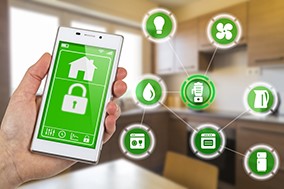Technology is always advancing, changing the way we go about our daily lives, conduct business, enjoy entertainment, and communicate with the world. Smartphones have been the center of this new, more connected world, and to this day continue to offer new and exciting ways we can complete even the most ordinary routines. While smart appliances and other connected home gadgets are not an entirely new invention, the way they’re integrated for use with our smartphones and even virtual assistants with voice recognition such as Amazon Alexa. From changing your thermostat setting from the warm and cozy comfort of your bedroom, to keeping a watchful eye on your children from the other side of the house. The array of smart devices available on the market is wide, with a smart version of nearly any appliance being offered, many at increasingly affordable prices. When connected to your home WIFI network, these gadgets can turn your home into a real life version of the science-fiction home of yesteryear! There is, however, one potential concern associated with all this connectivity- the risk of hackers. While the worry over a hacker gaining access to your phone, email account, or bank information may be easily understood, someone gaining access to your smart coffeemaker might be less apparent a threat. In the eyes of a hacker, turning your maker on at three in the morning while you’re sound asleep might be little more than a prank, but it could quickly become a much more serious situation. Running your coffee maker for hours on end could result in the device overheating and being permanently damaged. If not noticed quickly, an overheating appliance could lead to a fire risk. Hackers, be it digital thieves or troublesome trolls looking for a few quick laughs, can be a major concern and must be addressed. Thankfully, there are a few easy ways to help protect your devices, your network, and your home from their illicit attacks!
- Password protect your home WIFI network- Much as the traditional thief looks for an easy target with unsecured doors or windows, the digital thief of today looks for networks with little or no security. The first line of defense against them is using a password. Routers and modems often come with a factory-set password and is usually enabled by default. In the event that you don’t have the password enabled, make sure you fix that right away!
- Use unique and unpredictable passwords- While you might not easily remember the string of letters and numbers the router manufacturer provided as a default password, it’s that same unpredictable and unique nature that makes it an effective password. Simply searching someone’s name on social media can often provide a wealth of information about them, including family names and birthdays. Avoid using these for your passwords! Other easy-to-remember passwords, such as “Password” or “ABC123” are easy for a hacker to guess and could be the equivalent of leaving your house key sitting out on the porch. While it might seem old fashioned, writing down your passwords on a pad of paper can be an effective solution to a very modern problem.
- Use multiple passwords and change them frequently- In the typical digital space, hackers rarely infiltrate accounts one at a time- typically, passwords are ‘stolen’ in a large batch and are then linked to accounts and access is granted to your accounts. For a home network, the same can apply, albeit to a lesser degree. While the WIFI network in your house might use one password, it can be useful to use other passwords for your devices. Smartphones, tablets, or computers are more likely to be hacked or fall victim to a virus than your smart toaster, so ensure that these devices offer some layer of security separate from the main network password. Changing your passwords regularly can work to ensure that your passwords aren’t discovered now or in the future.
- Protect your passwords- Limit the number of devices that can access your home network. Many routers allow you to enable a ‘guest’ feature, limiting access to devices outside of your home’s primary inhabitants, often utilizing a separate password.
- Turn devices off or disconnect them when not in use- Many devices will offer sleep modes or an easy way to power down, often from the same app on your phone that lets you operate the device normally. If you’re leaving the house unattended, powering down devices is the ultimate insurance that they won’t be remotely accessed by a hostile entity. Baby Monitors are popular with homeowners, but are also an appealing target for hackers looking to invade your privacy- especially if their plans involve knowing when you are and aren’t home. Disable video cameras when not in use.
- Beware factory settings, resets, and persistent connections- Some devices may have factory settings that will have them connect to any available network in order to update their software. Make sure these settings are turned off, and any installations are only approved manually and when you’re around to supervise. While a smart device is capable of many things, a malfunctioning device likely won’t be able to stop itself from malfunctioning. These connections can also be insecure, and automatic network search could mean your devices connect to an outside network belonging to a neighbor (a minor inconvenience) or that of a hacker.
- Limit the use of range extenders and repeaters- While you don’t want dead zones in and around your home, powerful systems can have an extensive range… sometimes extending into public spaces, where hackers can see your network and begin trying to breach it. Experiment with the placement of such devices to ensure that your network is visible on your devices only when at home, and not when you’re at the café a few blocks away!
While home WIFI security can seem like an overwhelming responsibility, the everyday benefits of smart gadgets will often make the extra effort you put into protecting your home worth it! Play it safe with your smart devices when it comes to being connected to the outside world!


